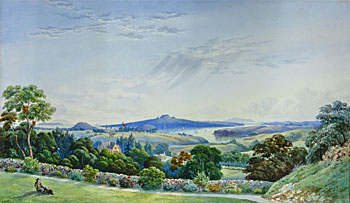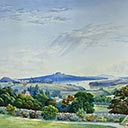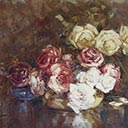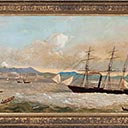Panorama of Auckland from Mt Hobson, Remuera
44 x 53 cm
est. $90,000 - 150,000
John Barr Clark Hoyte was prominent amongst landscapists of the 1860s and 1870s and is perhaps our best known watercolourist of the era. Hoyte spent his early years in Auckland, a founding member of the Auckland Society of Artists, establishing his studio in Scarborough Terrace, just off Parnell Road. The view Hoyte painted here is outstanding. It shows Tiritiri Matangi Island and Little Barrier to the left with the hills of Coromandel to the right. The spire in the middle left of the picture is that of St. Mary's Church, the other, rising above the library of Bishop's Court, St Stephens Avenue is still to be seen, although in 1910, the Bishop's private chapel was moved to Diocesan School in Epsom. Here we have one of the most panoramic views of Auckland. Several years after the completion of this work, John Logan Campbell tried unsuccessfully to purchase the land around Orakei which included the slopes of Mt Hobson. During an excursion to Remuera in 1881, Campbell climbed to the summit of Mt Hobson from where he 'gazed on the wonderful panorama which lay revealed to my sight for the first time'. This view further convinced Campbell that he had found the perfect site for the new capital. It was here in 1844 the Remuera Feast took place with the historic meeting between Hobson and Te Kawau. The Feast was intended as a sign of Waikato mana and a reminder of the continuing power and influence of local Maori. At the time, it is recorded as being one of the largest gatherings ever held in New Zealand. The Feast was attended by 4,000 Maori from seventeen tribes. Mt Hobson retains evidence of a tightly fortified pa on the summit. Many of the terraces, ditch defences, storage pits and middens are clearly visible around the cone's crest, except in the north west where a large flat topped reservoir is buried. It's western slopes are thought to have been extensive hillside Kumara gardens. Mt Hobson had earlier been sold to George Graham of the Royal Engineers who bought it as part of a larger block in 1844. However, after investigation of his ownership claims in 1847, the Crown retained that part of the land which now forms the Mt Hobson Domain. The hill was named in honour of Captain William Hobson, the first Governor of Auckland. It was the first hill Hobson climbed after his arrival in New Zealand. Hoyte is essentially an exponent of the picturesque landscape. While topographical interest remains high, it is always subordinate to the effects of light, space and atmosphere. His most marked stylistic peculiarity, the sign of 'Hoyteness', is that lapis blue, bright and deep, which fills the depths of his valleys, and the profoundest of his shadows. A contemporary reviewer speaks of his full and pure colour as based upon sound principles of aerial perceptive - and that may, indeed, have been the intention of those characteristic blazes of blue. Hoyte later moved south to Dunedin before travelling to Australia, where he held various posts as a drawing master to supplement what proved to be variable income. He died in Sydney in 1913. It is as a portrayer of the scenic beauties of the Dominion that he will long be remembered. This work is possibly the finest example in private ownership.





